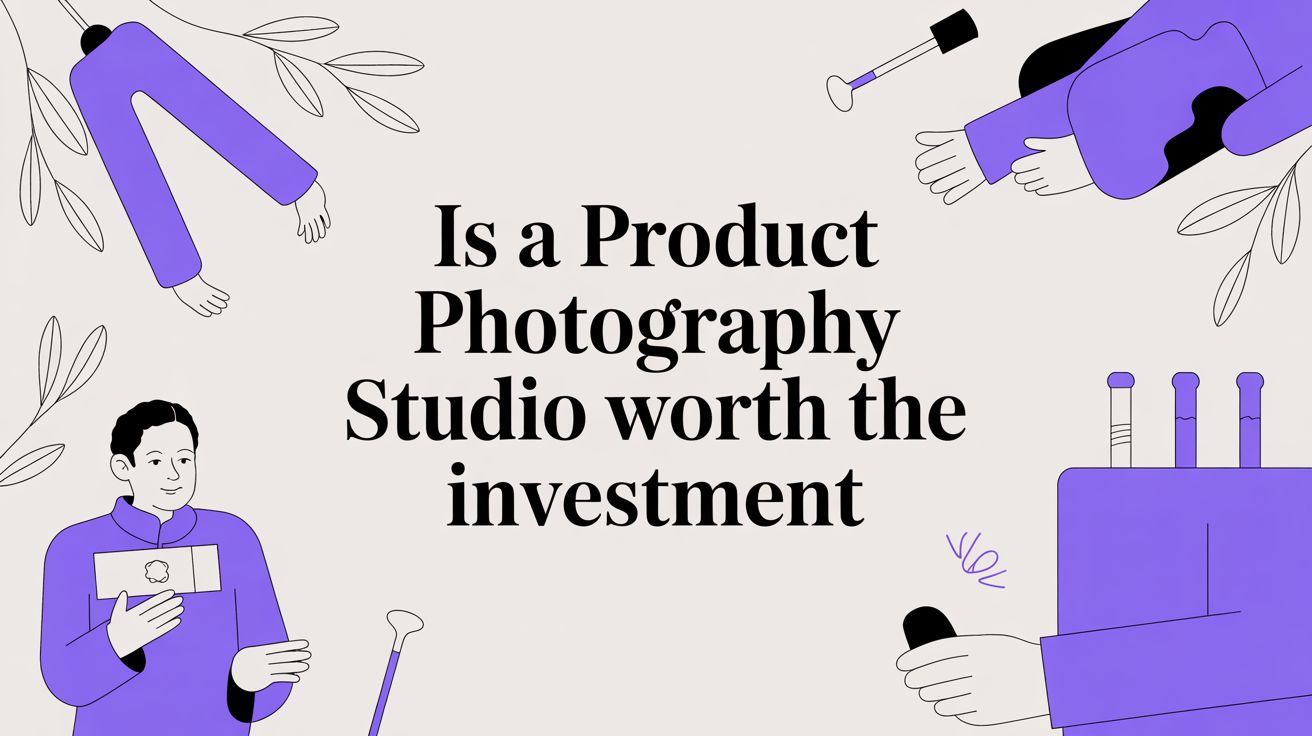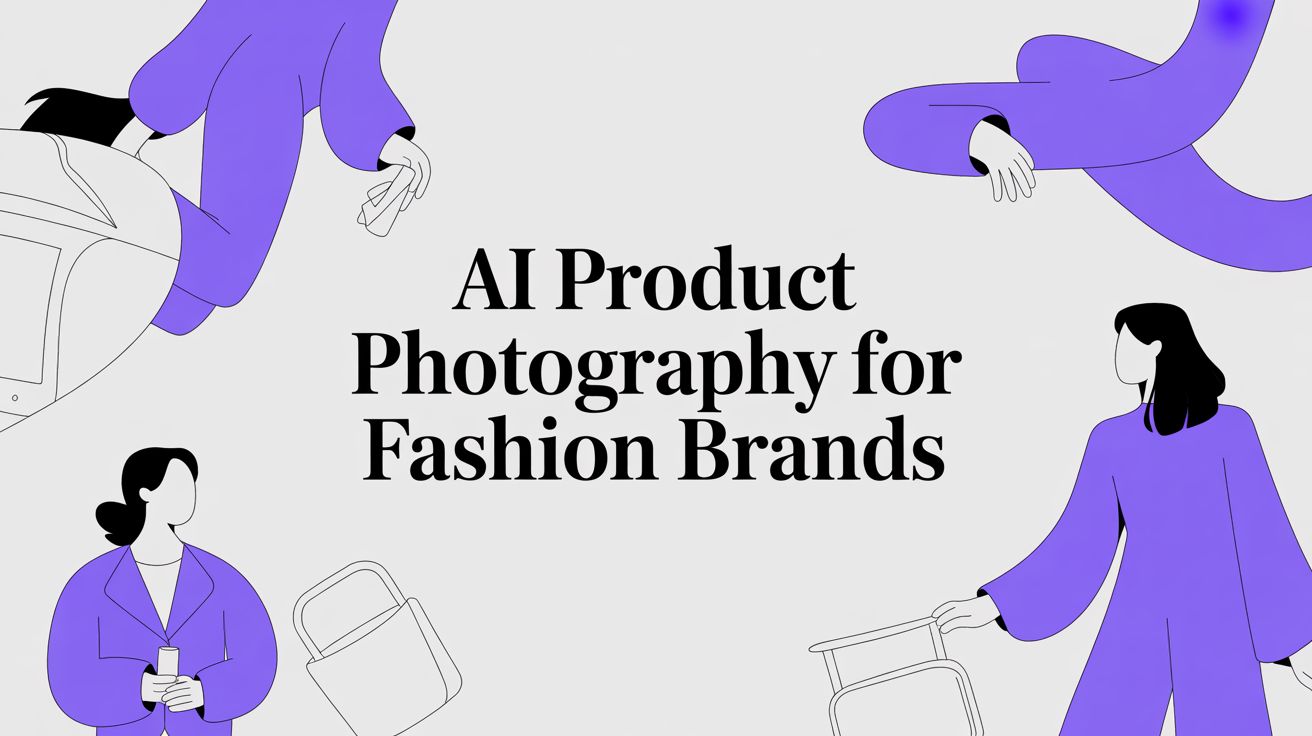How AI is Replacing Expensive Equipment for Studio Photography
Discover the essential equipment for studio photography. Our guide covers cameras, lighting, and AI tools to help your apparel brand create stunning images.
How to start saving money
Lorem ipsum dolor sit amet, consectetur adipiscing elit lobortis arcu enim urna adipiscing praesent velit viverra sit semper lorem eu cursus vel hendrerit elementum morbi curabitur etiam nibh justo, lorem aliquet donec sed sit mi dignissim at ante massa mattis.
- Neque sodales ut etiam sit amet nisl purus non tellus orci ac auctor
- Adipiscing elit ut aliquam purus sit amet viverra suspendisse potent i
- Mauris commodo quis imperdiet massa tincidunt nunc pulvinar
- Adipiscing elit ut aliquam purus sit amet viverra suspendisse potenti
Why it is important to start saving
Vitae congue eu consequat ac felis placerat vestibulum lectus mauris ultrices cursus sit amet dictum sit amet justo donec enim diam porttitor lacus luctus accumsan tortor posuere praesent tristique magna sit amet purus gravida quis blandit turpis.

How much money should I save?
At risus viverra adipiscing at in tellus integer feugiat nisl pretium fusce id velit ut tortor sagittis orci a scelerisque purus semper eget at lectus urna duis convallis. porta nibh venenatis cras sed felis eget neque laoreet suspendisse interdum consectetur libero id faucibus nisl donec pretium vulputate sapien nec sagittis aliquam nunc lobortis mattis aliquam faucibus purus in.
- Neque sodales ut etiam sit amet nisl purus non tellus orci ac auctor dolor sit amet
- Adipiscing elit ut aliquam purus sit amet viverra suspendisse potenti
- Mauris commodo quis imperdiet massa tincidunt nunc pulvinar
- Adipiscing elit ut aliquam purus sit amet viverra suspendisse potenti
What percentage of my income should go to savings?
Nisi quis eleifend quam adipiscing vitae aliquet bibendum enim facilisis gravida neque. Velit euismod in pellentesque massa placerat volutpat lacus laoreet non curabitur gravida odio aenean sed adipiscing diam donec adipiscing tristique risus. amet est placerat imperdiet sed euismod nisi.
“Nisi quis eleifend quam adipiscing vitae aliquet bibendum enim facilisis gravida neque velit euismod in pellentesque massa placerat”
Do you have any comments? Share them with us on social media
Urna ut fermentum imperdiet lacus, elementum etiam maecenas libero nunc, suspendisse massa, nisl, elit curabitur feugiat in quis ut nibh enim in tristique aliquam sed vitae dui, dis adipiscing pharetra aliquam turpis turpis nibh rhoncus enim, pellentesque leo laoreet neque in sed bibendum fermentum suspendisse tempus non purus adipiscing suscipit fringilla adipiscing convallis dolor nulla fermentum facilisis ullamcorper ut vehicula tortor libero metus donec velit, tristique fermentum, dictum euismod diam scelerisque enim non pharetra tristique lectus habitant pharetra est id
When an emerging fashion brand like Reformation needs to showcase a new collection, the traditional route involves a full-scale photoshoot — a process that costs thousands and takes weeks. But a smarter approach is emerging. By blending minimal physical gear with AI-powered virtual studios, brands are now creating stunning campaigns at a fraction of the cost and time. This isn't just about saving money; it's about transforming the entire content creation pipeline.
This guide outlines the essential equipment for studio photography and shows how AI tools like Picjam are offering a more efficient alternative.
Your Core Studio Photography Equipment Checklist
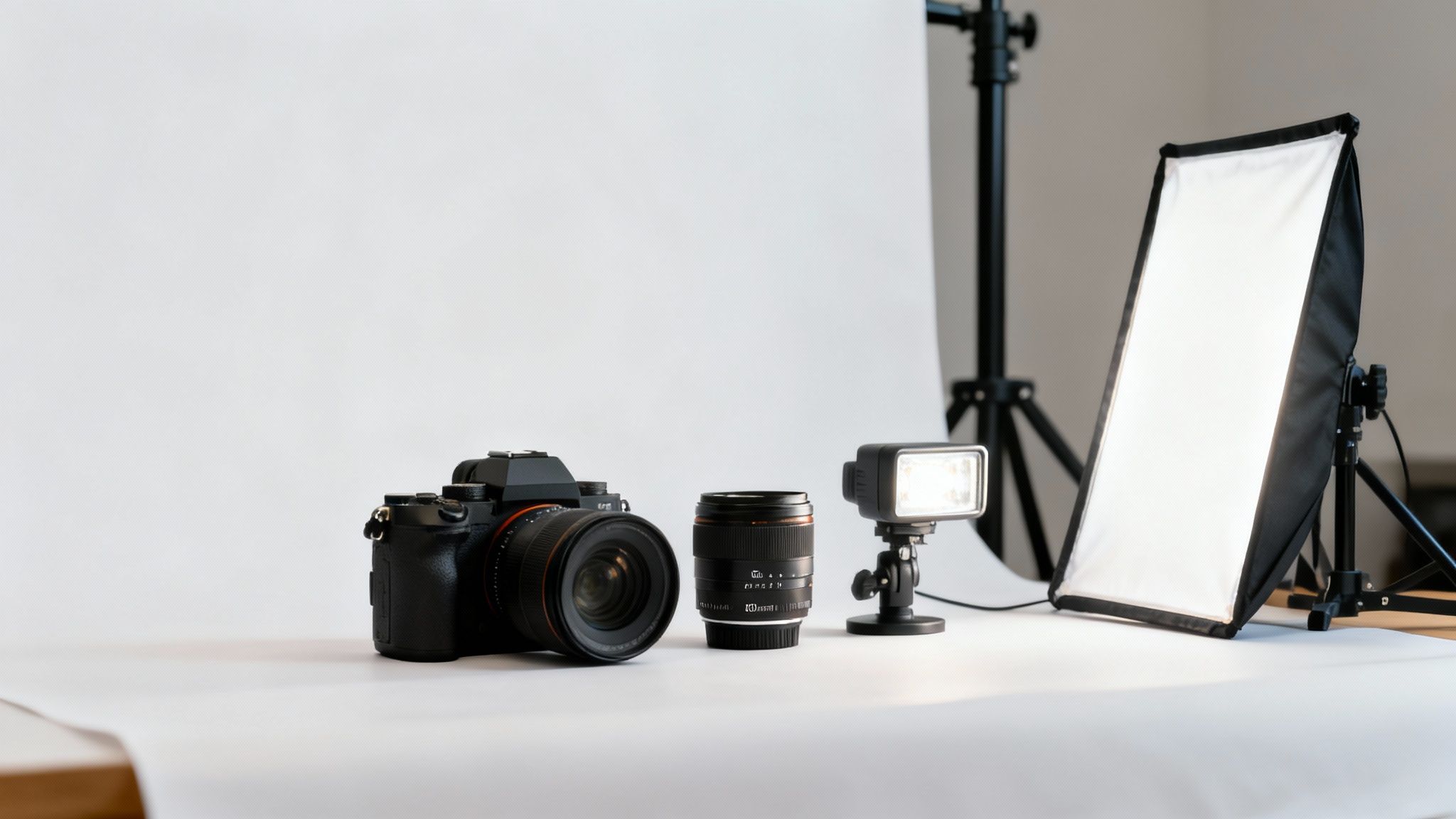
Putting together an in-house studio is a strategic investment in creating the high-converting visuals your apparel brand needs. The global photography equipment market hit $25 billion in 2023 and is expected to climb by 5.5% annually until 2033, driven by the relentless demand for quality e-commerce visuals.
For a fashion brand, this means acquiring a kit that delivers total control over quality and consistency.
The key is to start smart. Focus on the non-negotiables that will make the biggest impact immediately.
This table breaks down what you absolutely need to launch versus what you can add as your brand grows.
How to Prioritize Your Studio Equipment Purchases
This table provides a clear roadmap. Start with the "Essential" column to build a powerful, functional studio.
The Must-Have Gear for Day One
The heart of any great photo setup is the camera and lens. A full-frame mirrorless camera paired with a sharp prime lens is essential. A combo like a Sony A7 series camera with a 50mm lens is what allows brands like Everlane to capture crisp fabric details.
Now for the real game-changer: lighting. A solid one or two-strobe setup is what separates amateur shots from pro-level imagery.
- Key Light: This is your main light source. It carves out the product's shape and defines its texture. A powerful choice for smaller studios is the Godox AD400 Pro.
- Fill Light: This softens any harsh shadows cast by the key light. Often, a simple white reflector does the job perfectly.
Essential Supports and Surfaces
Your expensive gear needs sturdy support, and this is not the place to cut corners. Investing in C-stands is a smart move for stability and safety.
Finally, you need a clean stage. A seamless paper backdrop in white, grey, or black instantly isolates your apparel.
For clothing, a mannequin on a stand is crucial for getting the garment to hang perfectly.
But what if the cost, space, and technical expertise become a roadblock? This is where modern tools like Picjam come in. The platform lets you generate studio-grade images without owning a single piece of physical equipment, saving you thousands.
How to Shape Light for High-End Fashion Imagery
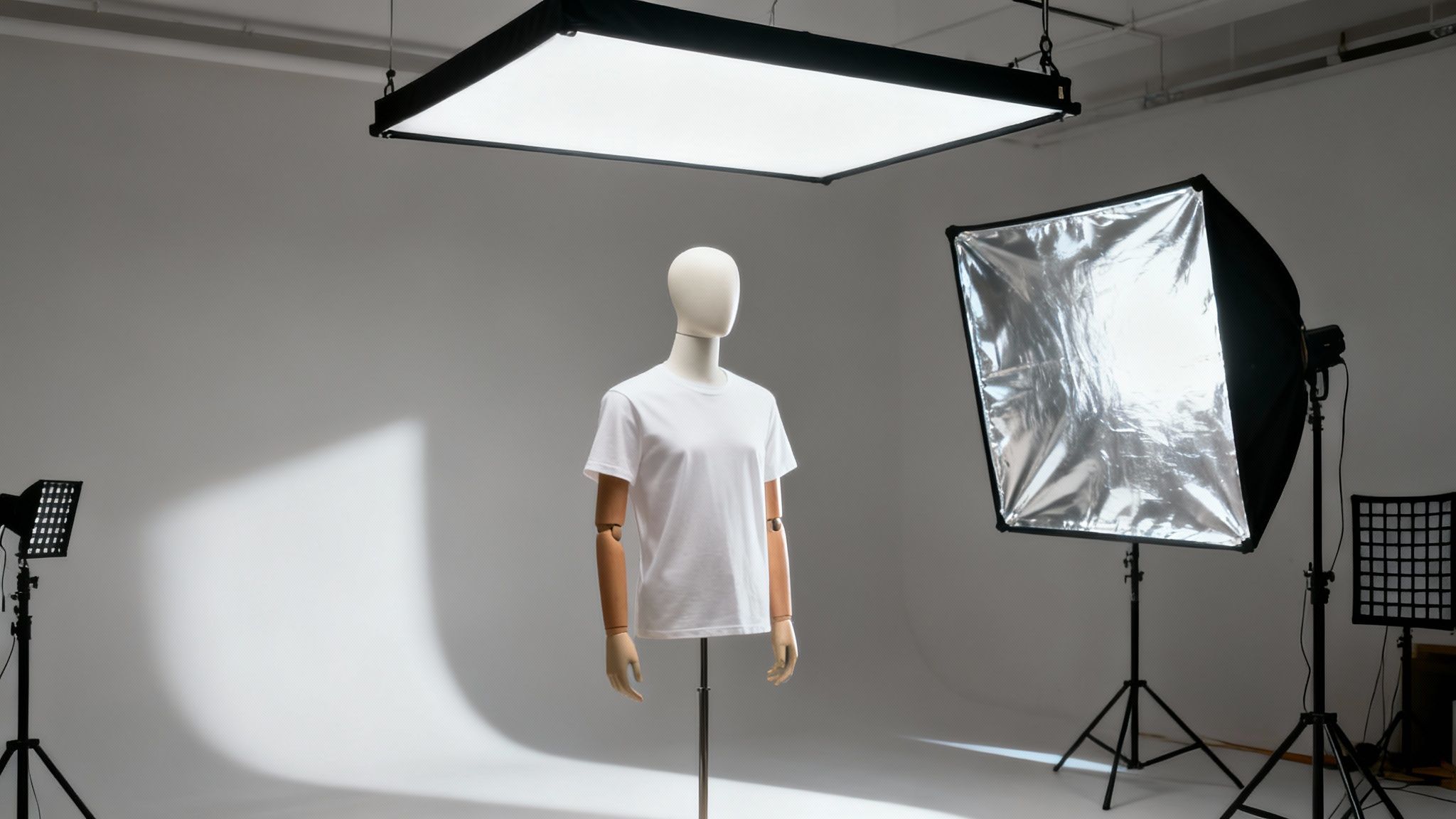
Great product photography isn't about how powerful your flash is. It's about how you control it.
Light modifiers sculpt a raw strobe into the soft, flattering light that makes apparel look incredible.
The market for photographic lighting gear was valued at $2.3 billion in 2023 and is set to grow at a CAGR of 4.7% through 2033. Brands know investing in light-shaping tools is a direct investment in better photos. You can explore the full market research on lighting equipment here.
The Softbox: Your Go-To for Flattering Light
The softbox is the undisputed workhorse of studio photography. It fits over your flash and pushes light through a diffusion panel.
The result is a beautiful, soft glow that wraps around your product. Think about the clean look of brands like Reformation. Their on-model shots have that soft, forgiving quality that makes clothes look appealing. That’s a well-placed softbox.
Remember this principle: the larger the light source relative to your subject, the softer the light will be.
- Large Softbox (48" or bigger): Best for full-body shots, creating an even, soft light.
- Small Softbox (24" or smaller): Perfect for details, producing more focused light with defined shadows.
The Beauty Dish: For Sculpted Definition
When you want a more chiseled look, use a beauty dish. It produces light that’s soft but with a crisp edge.
You’ll see this in beauty campaigns and high-fashion lookbooks. It’s perfect for sculpting features and creating a polished aesthetic.
Pro Tip: Want to soften a beauty dish? Use a fabric "sock" diffuser. This gives you a light quality that’s a perfect hybrid between a standard beauty dish and a small softbox.
Grids and Reflectors: The Precision Tools
Grids are honeycomb inserts that stop light from spilling everywhere. They narrow the beam to create a focused pool of light, perfect for dramatic shots.
Reflectors are deceptively simple but powerful. A basic white foam board or a 5-in-1 disc can bounce light back into shadows, filling in dark spots.
How to Choose the Right Camera and Lens for Apparel

Your camera and lens translate a physical garment into the digital asset that convinces a customer to buy.
Why Full-Frame Cameras Deliver Superior Detail
While modern crop sensor cameras are good, a full-frame sensor is the top choice for professional apparel photography. Its larger surface area gathers more light, translating to better image quality, richer colors, and sharper details.
A bigger sensor lets you capture the fine weave of denim or the subtle texture of silk. That detail builds trust and reduces returns. Full-frame mirrorless cameras, like the Sony A7 series, are industry favorites.
How Focal Length Impacts Your Fashion Shots
Lenses are defined by their focal length, measured in millimeters (mm). For most fashion brands, sharp and bright prime lenses are the best place to start.
Here are two workhorses for any fashion studio:
- 85mm Prime Lens: The classic portrait lens. It creates flattering compression, perfect for on-model lookbook shots, and melts the background away to keep focus on the clothes.
- 50mm Prime Lens: Unbelievably versatile. Its field of view is close to what our eyes see, making it a great all-rounder for half-body model shots and detailed flat lays, which we cover in our complete guide to flat-lay apparel photography.
A prime lens forces you to "zoom with your feet." Moving to frame your shot makes you more intentional about angles and composition, often leading to stronger images.
When a Zoom Lens Streamlines Your Workflow
While primes offer incredible image quality, a top-tier zoom lens offers pure flexibility. A 24-70mm f/2.8 lens is a studio workhorse, letting you jump from wide to tight shots without swapping lenses.
This is a game-changer for brands shooting varied content. Imagine an activewear brand like Lululemon — they need clean studio shots and dynamic lifestyle images. A zoom lens makes that workflow smoother, but often comes with a higher price tag.
How to Build a More Efficient Studio Workflow
An efficient studio runs on more than just lights and cameras. It requires robust stands, versatile backdrops, and time-saving tools.
The global photo studio industry is massive, projected to be worth $37 to $46 billion by 2025. This boom is fueled by demand for branded content, but smart money is on tech that makes the process smoother. You can dive deeper into the photo studio industry statistics here.
Why Sturdy C-Stands Are a Non-Negotiable Investment
A basic light stand is a risky place to save money. A heavy strobe on a flimsy stand is an accident waiting to happen. That's why pros use C-stands.
Made of solid steel, C-stands are the bedrock of a safe studio. Their weighted "turtle base" makes them incredibly difficult to tip over. Think of it as an insurance policy for your expensive equipment.
How to Set the Scene with Backdrops
Your backdrop is the canvas for your product. For true control and consistency, you need a dedicated background.
- Seamless Paper: The industry standard. It delivers a perfectly smooth, non-reflective surface. Brands like Glossier master this, using signature colors to build a recognizable brand world.
- Painted Canvas: Adds texture and depth for more atmospheric lookbooks, injecting an artistic vibe.
Investing in core backdrop colors — typically white, black, and a mid-tone gray — gives you a versatile toolkit.
How Tethered Shooting Eliminates Costly Reshoots
Shooting tethered is one of the biggest upgrades you can make to your workflow. You connect your camera to a laptop with software like Capture One or Lightroom.
You see every shot instantly on a large screen. This real-time feedback loop is a game-changer for apparel photography.
Spotting a stray thread the moment you take the picture allows you to fix it on the spot. This process is non-negotiable for high-volume e-commerce brands, ensuring perfection and slashing the need for expensive reshoots. Mastering this is a critical part of your overall photo shoot prep.
How AI Is Replacing Traditional Studio Gear
For decades, quality brand imagery required investing thousands in equipment for studio photography. That is no longer the only path. AI-powered virtual studios let brands skip the expensive gear altogether.
This new approach lets brands create photorealistic, on-model images without a single light, camera, or backdrop. Think of a brand like Allbirds testing a new sneaker colorway. Instead of a complex shoot, they could generate hundreds of diverse product shots in hours.
Platforms like Picjam are leading this charge, cutting through the usual expenses of studio rentals, photographer day rates, and model fees. This isn't just about saving money; it’s about unlocking new levels of speed and creative freedom.
The Hybrid Model That Slashes Content Costs
One of the smartest ways to use AI in fashion is the hybrid model. It blends a minimal physical setup with a virtual studio to create a cost-effective content engine.
Here’s how it works: a brand takes a basic shot of a garment on a mannequin. Then, they use an AI platform to place that garment onto a variety of virtual models in any setting imaginable — from a clean studio to a sun-drenched street in Paris.
This process turns a single photo into a nearly infinite library of marketing content, slashing production costs.
For example, a boutique could show its latest dress on 10 different models in 5 different locations, creating 50 unique marketing assets from one mannequin photo. This kind of output used to be reserved for brands with six-figure budgets. Our guide on AI product photography dives deeper into how this tech changes the game.
This decision tree helps visualize how to prioritize gear investments for a smarter workflow.
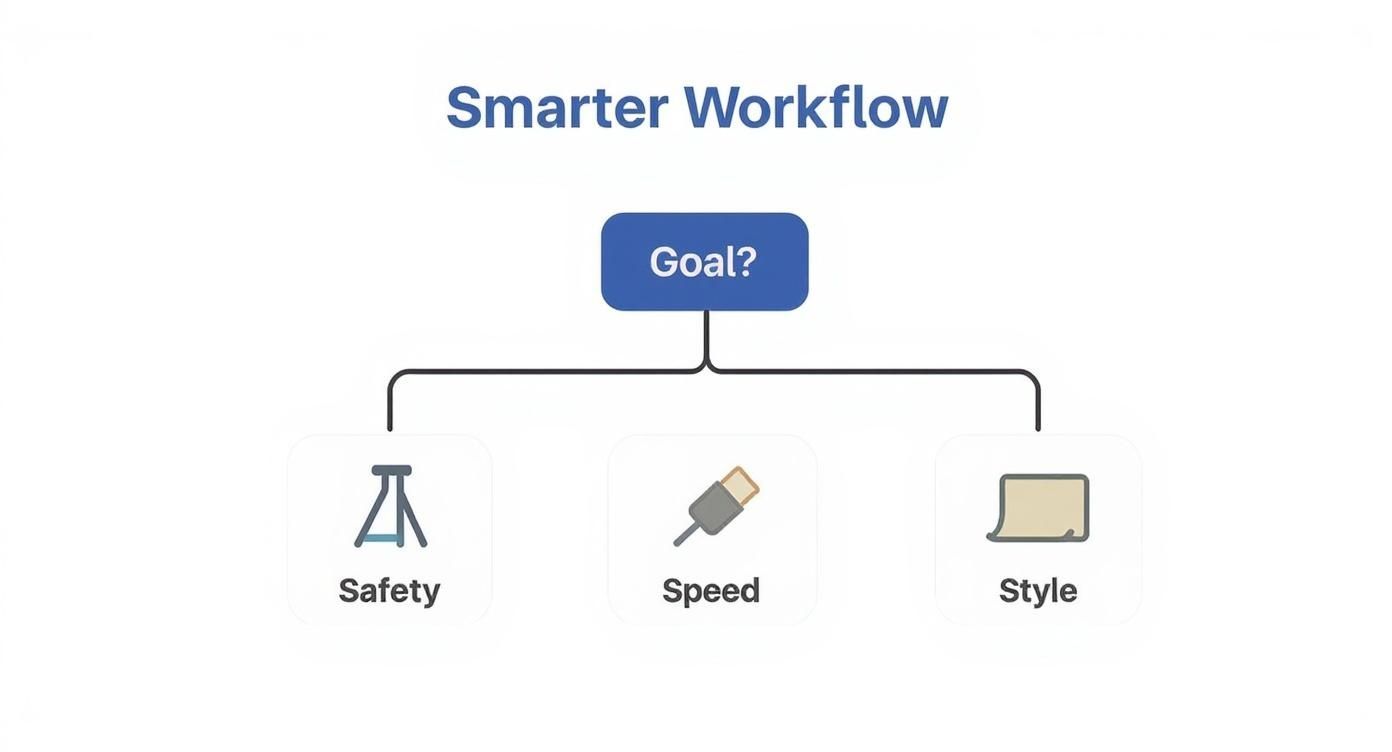
As the chart shows, your gear choices impact safety, speed, and style — the exact areas where AI offers a powerful, low-cost alternative.
How AI Unlocks Major Savings for Fashion Brands
The financial argument for integrating AI is compelling. McKinsey reports that generative AI could add $150 billion to $275 billion to the operating profits of the apparel, fashion, and luxury sectors, driven by tangible savings on content production.
Consider the line items for a traditional photoshoot:
- Photographer: $1,000 – $5,000 per day
- Model: $500 – $2,000+ per day
- Studio Rental: $400 – $1,500 per day
- Stylist & MUA: $1,000+ per day
These costs stack up fast. AI platforms replace these variable costs with a predictable subscription. This frees up budget for growth areas like marketing or product development.
Takeaway: Upgrading Your Brand's Photography
Leveling up your brand's look boils down to a few smart moves. Whether setting up a physical studio or exploring virtual solutions, these actions will deliver high-converting images.
Invest in Lighting First, Not a Camera
The single most important investment you can make is in good lighting. One solid strobe with a large softbox will yield far better results than a top-of-the-line camera in bad light.
- Action 1: Master a One-Light Setup. Get proficient with a single key light. A Godox AD400 Pro with a 48" octabox and a white foam board for fill is the foundation of pro e-commerce photography.
- Action 2: Buy C-Stands, Not Flimsy Kit Stands. Protect your gear and ensure set safety. C-stands are a one-time purchase that will outlast your brand. Cheap stands are a false economy.
Think Like a Content Factory, Not a Photo Studio
The future of fashion content isn't about expensive photoshoots; it's about maximizing the value of every photo. AI tools like Picjam let you turn one product shot into an entire campaign.
- Action 3: Test a Hybrid Workflow. Take a clean shot of your product on a mannequin. Upload that image to an AI platform to place the garment on dozens of virtual models in countless settings. You multiply your marketing assets without booking a single model or location.
Ready to see how an AI-powered workflow compares to your current photography costs?
Picjam team
Pellentesque leo laoreet neque in sed bibendum fermentum suspendisse tempus non purus adipiscing suscipit fringilla adipiscing convallis dolor nulla fermentum facilisis ullamcorper ut vehicula tortor lib.


